Kodak Easyshare P712 Review
Review Date: September 1st 2006
Leave a comment about this Review
|
Ease of Use
When you consider that the Kodak Easyshare P712 offers a 12x zoom lens equivalent to a massive focal length of 36-432mm, it's surprising just how small this camera actually is. The Kodak Easyshare P712 offers a good compromise between portability (think small camera bag) and handling that will instantly appeal to anyone who has used an SLR camera before. Weighing around 400g with the battery and memory card fitted, the Kodak Easyshare P712 has a reassuring feel, helped by the deep hand-grip and durable black plastic body. The 12x ultra-zoom, Schneider Kreuznach branded lens is obviously the main attraction of this camera, with the giant lens barrel and large 2.5 inch LCD screen dominating the overall design. The huge zoom lens obviously makes this one of the most versatile compacts in terms of focal range, especially as it is coupled with an optical image stabilization system, which helps to ensure that the majority of photos taken in good light are sharp. If you're used to a 3x zoom lens, then the 12x zoom will be like a breath of fresh air and should handle most photographic possibilities, with the exception of true wide-angle shots.
There is no true optical viewfinder, but Kodak have provided an electronic version with 237,000 pixels and diopter adjustment, which protrudes from the back of the camera like the EVFs found on many camcorders. The EVF on the Kodak Easyshare P712 is very useful when the LCD screen is difficult to see, for example in very bright sunlight, or when you're using the longer focal lengths, as it allows you to keep the camera steady at the telephoto end of the zoom by holding it up to your eye. This is helped by the lens' quick maximum aperture of f/3.7 at the maximum telephoto focal length of 432mm. There aren't too many weak-points in terms of the Kodak Easyshare P712's design and build-quality - for once the battery compartment and SD card slot are both very well implemented, and even the tripod mount is metal and located in the middle of the camera body. The only aspects of the design that slightly disappoint are right-hand strap eyelet, which is positioned so that it digs into your hand when gripping the camera, and the slightly flimsy plastic zoom lever.
The Kodak P712 offers a full range of manual exposure settings, and Kodak have chosen to make many features accessible via external buttons, which means that this is quite a complex camera in terms of the number of external controls that it has. I counted 20 in total, which could prove intimidating for the beginner, although the majority of them are clearly labeled and common to most cameras. There's a traditional dial on the top of the camera that lets you select the different exposure modes; Program, Shutter Priority, Aperture Priority and Manual, plus the various scene modes. This dial is a typical feature of SLR cameras, and enables you to quickly change between the different shooting modes. There are also 3 customs shooting modes, allowing you to setup and quickly access your own customised shooting settings. The Program button is also a nice touch - you can customise it to bring up a particular sub-menu, for example the White Balance options.
| Mode Dial / Drive Button / Program Button / Metering Button | On/Off/Favourites Lever / Shutter Button |
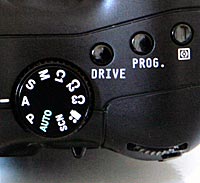 |
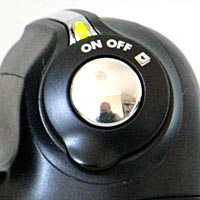 |
The Kodak P712 has a unique way of accessing the various exposure options, which are displayed as icons along the bottom of the LCD screen and EVF. You have to press the Set button and then use the dial above it to choose from shutter speed, aperture, exposure compensation, flash compensation and ISO speed, and then press the Set button and use the dial again to be able to alter one of those settings. It takes some time to get used to, but does work fairly well when you get used to it, providing centralised access to the key exposure settings. The Focus button lets you choose between normal auto-focusing, macro, infinity and manual focusing. The latter option works quite well, although it is quite a tricky and slow process. The centre of the LCD screen shows a magnified view, with a horizontal distance scale on the left. You use the joystick to select a certain distance to achieve sharp focus, and there's also a vertical scale to show how close you are to achieving correct focus (as judged by the camera).
If you have never used a digital camera before, or you're upgrading from a more basic model, reading the easy-to-follow manual before you start is a good idea, although it doesn't go into any great depth. Thankfully Kodak have chosen to supply it in both printed format and as a PDF on a CD, so you can also carry it with you. You can use either the large 2.5 inch LCD screen or the electronic viewfinder (complete with dioptre adjustment) to frame your shots. The LCD screen has just 115,000 pixels, whilst the EVF offers 237,000 pixels. You have to press the EVF/LCD button to switch between them. The various icons used to represent the camera settings are clear and legible, even on the small EVF.
| Joystick | Zoom Lever / Dial / Set Button / Info Button / AE/AF Button |
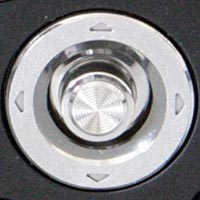 |
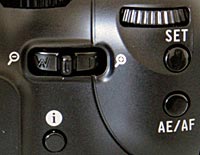 |
The main menu system on the Kodak Easyshare P712 is straight-forward to use and is accessed by pressing the Menu button underneath the navigation pad/joystick. Depending upon the shooting mode, there are two or three main menus, Record, Record+ and Setup. A lot of the camera's main options, such as white balance, image quality, auto-focus mode and colour mode, are accessed here, so the menu system has 37 options spread in total. Due to the large LCD screen and restricting the number of on-screen choices to six, the various options and icons are clear and legible, although I didn't really like the transparent menus.
There is an innovative feature on the Kodak Easyshare P712 that aims to make life easier for you. This camera has an optical image stabilization system - turn it on and the Kodak Easyshare P712 automatically compensates for camera shake, which is a slight blurring of the image that typically occurs at slow shutter speeds. In practice I found that it does make a noticeable difference, as shown in the examples on the Image Quality page. You don't notice that the camera is actually doing anything different when anti-shake is turned on, just that you can use slower shutter speeds than normal and still take sharp photos. However, what Kodak gives you in the form of an effective anti-shake system, it takes away by only providing a limited effective ISO range of 64-200. This essentially means that you really need to leave the anti-shake system turned on all the time to compensate for the slow shutter speeds, especially as ISO 400 and even ISO 200 exhibit a high levels of noise (see the Image Quality page), which negates some of the advantages that the stabilization system offers. Thankfully leaving the anti-shake system on didn't negatively affect the battery-life, with the camera managing over 250 shots using the supplied rechargeable Li-ion battery before needing to be recharged.
| Battery Compartment | Memory Card Slot |
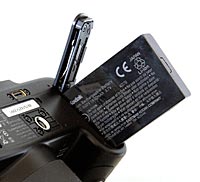 |
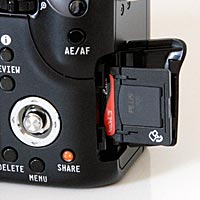 |
The start-up time from turning the Kodak Easyshare P712 on to being ready to take a photo is not particularly quick at around 3.5 seconds, but remember that this is an ultra-zoom camera. Zooming from the widest focal length to the longest is also slow at around 4 seconds, but again this is perhaps understandable given the massive focal range. Focusing is quick in good light and the camera achieves focus most of the time indoors or in low-light situations, although it tends to hunt at the telephoto end of the zoom range. Note that there is no focus-assist lamp. The visibility and refresh rate of the 2.5 inch LCD screen are perfectly acceptable, although it's a little grainy due to the low number of pixels used (115,000). It takes about 1.5 seconds to store a JPEG image, allowing you to keep shooting as they are being recorded onto the memory card - there is a very short LCD blackout between each image. RAW and TIFF files are a different story entirely, with RAW files taking 10 seconds and TIFF files over 15 seconds to store, during which time you can't take another picture or alter menu settings. The Kodak Easyshare P712 has a below average continuous mode which enables you to take 1.6 frames per second at the standard JPEG image quality. Overall the Kodak Easyshare P712 is quite slow in terms of operational speed, especially if you use the RAW or TIFF file formats.
Once you have captured a photo, the Kodak Easyshare P712 has a good range of options when it comes to playing, reviewing and managing your images. You can instantly scroll through the images that you have taken, view thumbnails, zoom in and out up to 10x magnification, view slideshows, delete, protect, resize, copy and rotate an image. You can also select favourite images, set print options, and email images. The Info button toggles detailed settings information about each picture on and off, such as the ISO rating and aperture / shutter speed, and there is a small histogram available during both shooting and playback. When taking a photo, pressing the Info button toggles between the detailed information, detailed information with histogram and no information at all. For movies, there are a wealth of in-camera editing options. You can create prints from video frames (4, 9, or 16-up), view and share single frames, plus trim, cut, split and merge your videos.
RAW files get a special mention, as you can actually alter them in-camera, with options for changing the image size and type, exposure, colour mode, sharpness, contrast and white balance. Unfortunately it takes over 15 seconds to apply the changes and save as a JPEG version, and I'm not sure too many photographers will want to process their RAW files on a 2.5 inch LCD screen. Kodak's EasyShare software does offer the same options for developing the RAW file, but there are no third-party software programs that currently support the P712 (including Adobe Photoshop).
In summary the Kodak Easyshare P712 is an SLR-like bridge camera with the defining feature of a huge 12x image stabilized lens, which is straight-forward to use and can be customised to suit your own needs, although its general operation is not particularly quick.
|
![]() PhotographyBLOG
is a member of the DIWA
organisation. Our test results for the Kodak Easyshare P712
have been submitted to DIWA
for comparison with test results for different samples of
the same camera model supplied by other DIWA
member sites.
PhotographyBLOG
is a member of the DIWA
organisation. Our test results for the Kodak Easyshare P712
have been submitted to DIWA
for comparison with test results for different samples of
the same camera model supplied by other DIWA
member sites.
